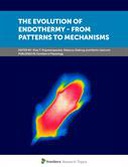Explore

The Evolution of Endothermy - From Patterns to Mechanisms
Over the last several decades, the oversimplified distinction between warm- and cold blooded animals has well and truly been put to rest and the terms “endo- and ectotherm” have been established. Birds and mammals are regarded as endotherms, capable of maintaining high body temperatures within highly precise boundaries. On contrary, in ectothermic organisms ambient temperature governs body temperature and metabolism, encompassing the majority of present day species. However, it has recently become very clear that this distinction is still not accurate enough to describe the vastness of heat generating mechanisms within endo- but also ectotherms. Indeed, a plethora of ectothermic animals display endogenous as well as behavioural means of temperature control and mechanisms for heat generation. There is large diversity in regards to thermoregulatory ability and strategy within endotherms as well, with some groups being classified by separate categories such as basoendotherms and mesotherms.
Considerable interest and efforts has been put into the quest to understand the underlying physiological mechanisms leading and facilitating high metabolic rates and body temperatures of endotherms. These mechanisms are far from being exhaustively studied and the evolutionary trajectory leading to high metabolic rates and stable body temperatures is equally, vividly debated. This discussion includes an array of questions and theories surrounding the presence of endothermy in extinct dinosaurs. In addition, a lively debate surrounds the evolutionary drivers promoting the establishment of endothermy with clear support of direct or indirect selective benefits.
Within this Research Topic we plan to compile the latest ideas, knowledge and experimental work to elucidate the patterns of the evolution of endothermy and its transition/distinction from ectothermy. The focus is on key physiological mechanisms supporting this transition and contributing to the maintenance of high metabolic rates and body temperature in endotherms, as well as mechanisms for local heterothermy and heat dissipation in ectotherms. These mechanisms and conclusions may be derived from different levels of organisation such as population, taxon, species as well as tissue, cellular or molecular levels. It may also encompass novel experimental or theoretical models testing evolutionary theories of endothermy. A comparative approach is encouraged but not fundamental.
This book is included in DOAB.
Why read this book? Have your say.
You must be logged in to comment.
Rights Information
Are you the author or publisher of this work? If so, you can claim it as yours by registering as an Unglue.it rights holder.Downloads
- 183 - mobi (CC BY) at Unglue.it.
- 208 - epub (CC BY) at Unglue.it.
- 152 - pdf (CC BY) at Unglue.it.
Keywords
- Birds
- Comparative Physiology
- ectotherms
- Endothermy
- Evolution
- heterothermy
- Mammals
- medicine
- Physiology
- Pre-clinical medicine: basic sciences
- thema EDItEUR::M Medicine and Nursing::MF Pre-clinical medicine: basic sciences::MFG Physiology
- thermoregulation
Links
DOI: 10.3389/978-2-88945-569-0Editions

